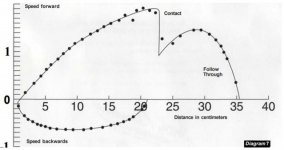Look up Jacksonville Project.Can't see it. Need proof.
pj
chgo
Look up Jacksonville Project.Can't see it. Need proof.
I'm not sure it answers the question, but all info related to this project can be found here:Look up Jacksonville Project.
See the 4th paragraph and linked video here:Can't see it. Need proof.
My article in the June 1999 issue of Billiards Digest is a start. It describes one of the tests during "The Jacksonville Experiment" which was mostly high-speed videos of pool shots. Here's a link to a set of articles about those tests:Can't see it. Need proof.
... because the forces between the tip and CB are incredibly large, much larger than what your arm "feels" during the incredibly brief contact time. For more info, see:One thing about contact time. If that's so insignificant, how is it a phenolic tip can put a hole in the cueball?
The last page in that article contains the following graph showing how the cue's speed drops on contact with the cue, even with a tight grip. Here's the relevant part of Bob's comment about it:My article in the June 1999 issue of Billiards Digest is a start. It describes one of the tests during "The Jacksonville Experiment" which was mostly high-speed videos of pool shots. Here's a link to a set of articles about those tests:
http://www.sfbilliards.com/Misc/jax_bd150.pdf

The data was gathered by taping a paper ruler to the cue stick and focusing the high-speed camera on the ruler during the stroke. The bumps in the data you are referring to were probably transcription errors from the video of the ruler onto paper (or into a text file). The physical situation is very unlikely to have bumps like that before contact because they indicate very high accelerations. The details of the measurement are in the referenced article.The above chart contains a marked anomaly which may be significant depending on whether or not it repeats in other strokes.
There is smooth acceleration in the stroke until the last six (6) measures before contact (mbc). At 5 mbc, acceleration drops for one measure and returns, approximately, to the prior speed (4 and 3 mbc). 2 and 1 mbc show deceleration just prior to contact.
Did this anomaly repeat? What was determined to be its cause?
![CropperCapture[582].jpg CropperCapture[582].jpg](https://forums.azbilliards.com/data/attachments/409/409026-954dc68b876edd94adda5a9307b3e3ac.jpg?hash=lU3Gi4du3Z)
Ok, scientists have intellectually enhanced common sense.
I'd like to see hi res data from a sensor placed in or on the tip and/or on the struck object and the ensuing spikes per loose, tight, and real tight grips.
Two experiments were illustrated above. Did you not understand the results?Some are saying definitively that grip tightness cannot have an impact on momentum imparted to the cue ball during contact because of the short contact time and the fleshy skin. It makes sense, but unless someone did the experiment to prove it then it is just a hypothesis. Did anyone actually test this or is it more of a "must be true" kind of thing?
Two experiments were illustrated above. Did you not understand the results?
For years and years I played with a death grip. I'd say the cueball action I got was very similar to what I have now. The difference is that it's easier to get a smooth stroke forward transition with a loose grip. It's easy to jerk the stroke a bit with a tighter grip. Also there will need to be some elbow drop involved to get a full motion of the cue. The tight grip does help if you are extremely nervous. You can't really ruin the stroke by overtightening the hand, as it is allready tight.
The reason why tight grips are perceived to deaden the action, particularly when it comes to draw strokes, is that tightening the grip at the last minute tends to jerk the tip upwards a little bit, so that you hit closer to center than intended. That same phenomenon can also jerk the tip sideways and cause you to miss more shots. If your grip stays tight, or you tighten it in a controlled fashion, it will no longer apply.
I can also spin/draw the ball with close to zero follow through AND a death grip, if I wish. It's a specialist stroke that is all wrist and very little if any arm involvement. I was taught by a carom player how to do that stroke. It comes up very rarely, but can be useful.